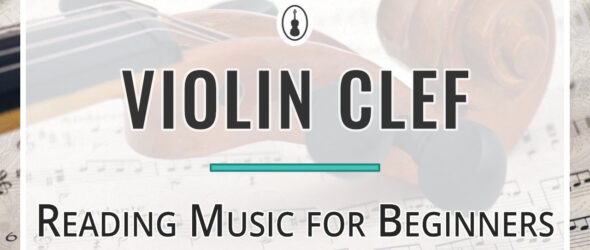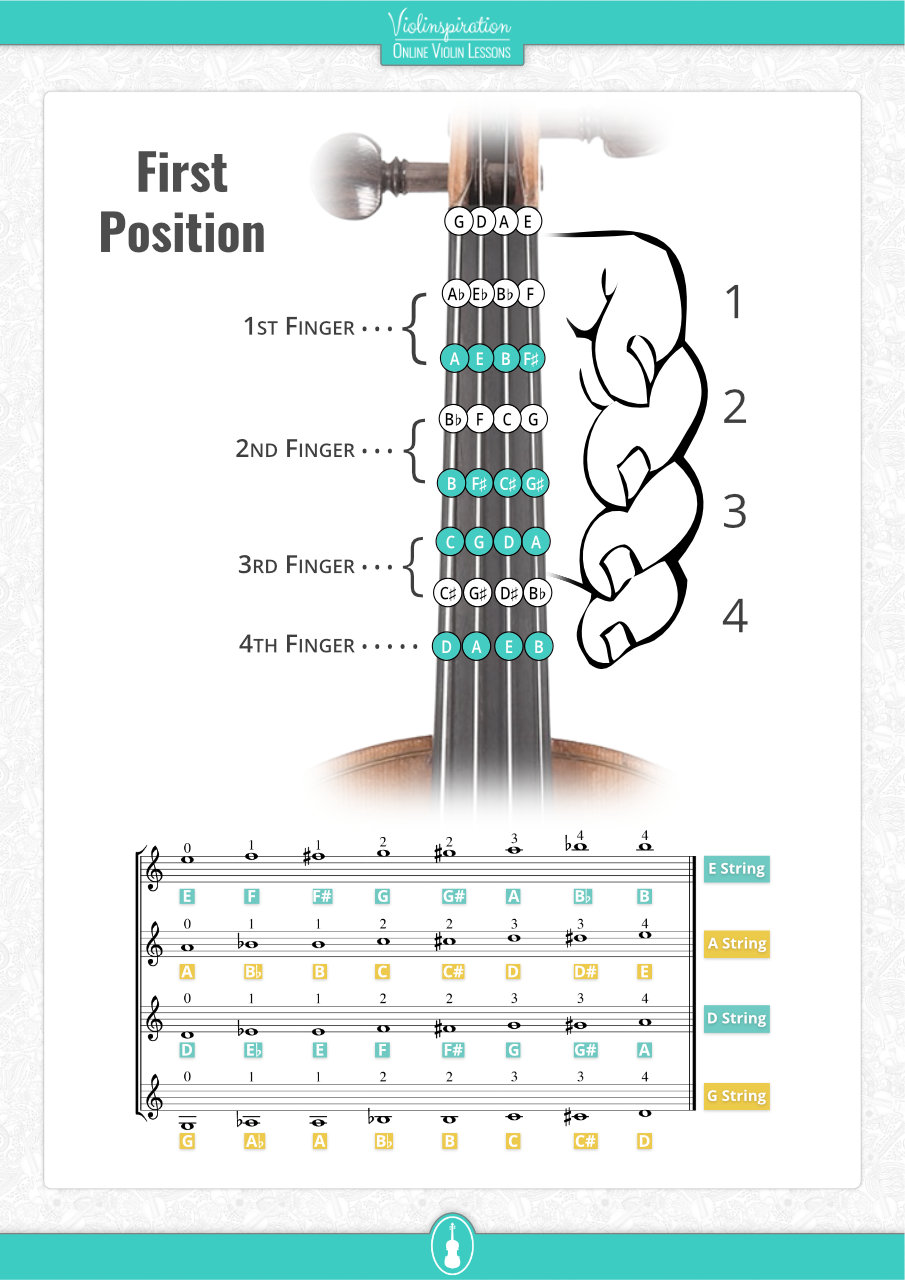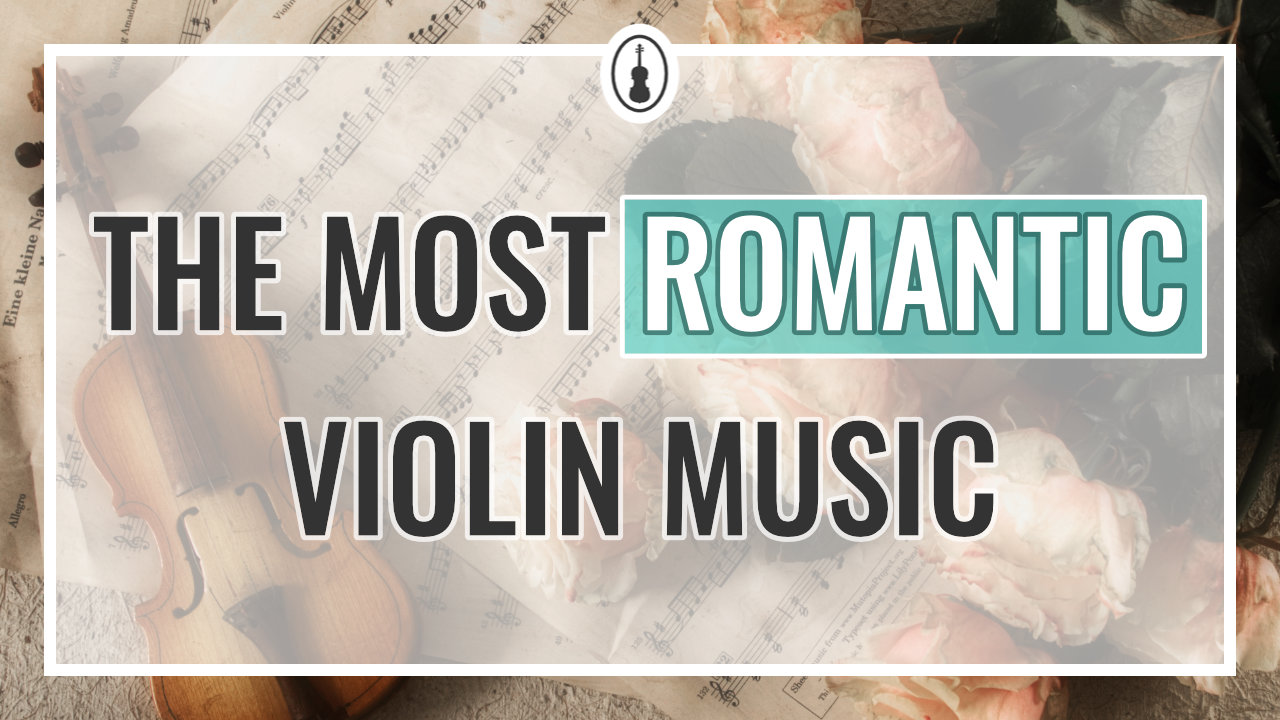A study on the violin clef, also known as the treble clef or G clef
When you open up your violin sheet music, the very first thing you’ll see on the music staff is the clef. It’s a very fancy-looking symbol, and it actually tells you a lot of information!
Different instruments will play using certain clefs. Today we’re zeroing in on the violin clef, what it looks like, and what it tells us. We’ll also discuss other clefs, and what they mean.
Let’s dive in!
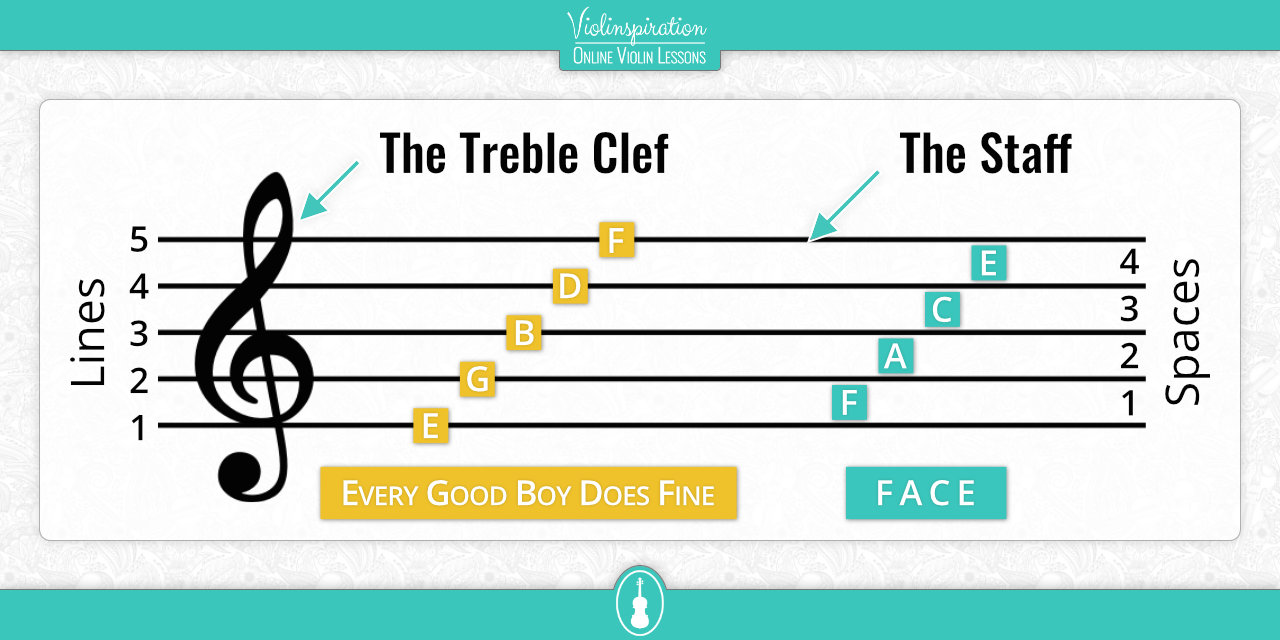
Getting Started: What is a Clef?
A music clef is a symbol that appears at the start of the music staff–the five lines and four spaces on which notes are written. The clef tells us which notes will correlate with the lines and spaces of the staff. This then lets us interpret the music accurately.
There are four different music clefs used in musical notation today:
Treble Clef: this clef shows the highest notes, and is also called the G clef.
Alto Clef: this one shows mid-range notes, and is also known as the C clef.
Tenor Clef: this clef indicates mid-range to low notes. It’s also a C clef, but it’s placed differently.
Bass Clef: this clef shows the lowest notes, and is also referred to as the F clef.
We’ll go over each of these clefs a little more in-depth later. For now, let’s focus specifically on the clef we’ll be using as violinists: Treble clef!
Treble Clef: The Violin Clef
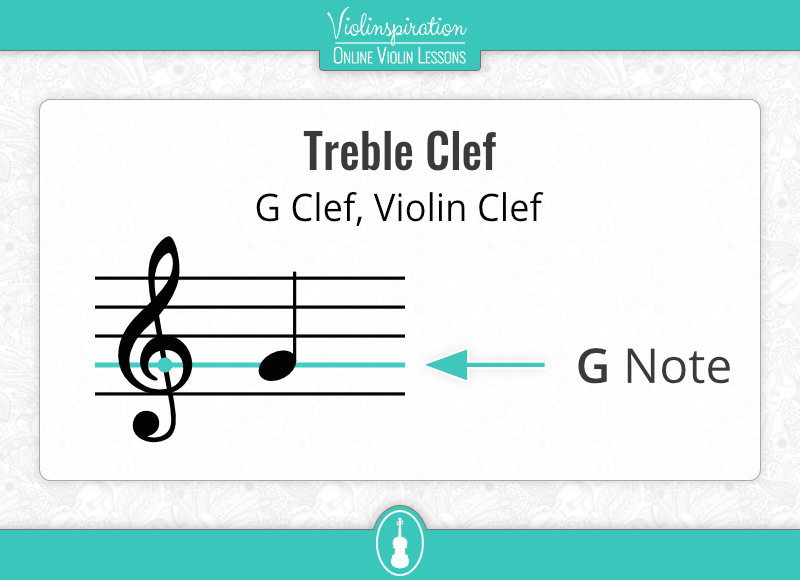
The only clef the violin plays is the treble clef, also called the G clef. This clef looks somewhat like a stylized G, and the middle of the spiral part of the clef wraps around the second line of the staff. Since the clef wraps around the second line, we call that specific note G. That’s how this clef got its name as the G clef!
The treble clef is used for higher-pitched instruments and voices, and shows the highest notes of all the clefs. The lowest line of the staff is E4, the E two steps above middle C; and the highest line of the staff is F5, which, on the violin, is played with the first finger on the E string.
As violinists, we only need to read treble clef for our standard music. Many of the notes we play on the violin are within the staff, but sometimes we’ll play low notes on the G string that extend lower than the staff itself, and other times we’ll play very high notes that sit above the staff. We add extra, short lines above or below the staff to read these notes. We call these ledger lines, and they can be added to any staff, no matter what clef you’re reading in, though the note names will change with the clef.
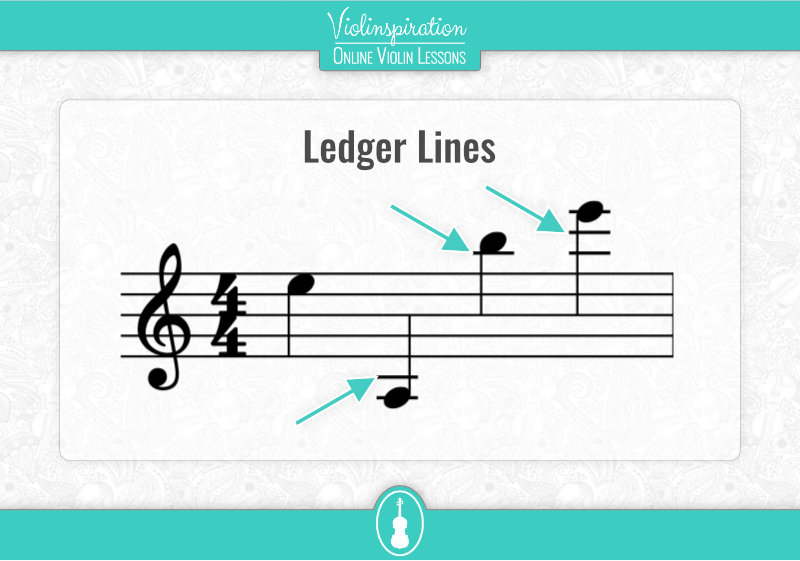
Other Clefs
Other clefs show different ranges of notes. Some instruments read from just one of these clefs, while other instrumentalists will have to read multiple.
The reason we have four different clefs is to avoid using many ledger lines. It can become confusing reading very high or very low ledger lines for extended periods of time. Personally, it makes my eyes very tired! Having clefs for different pitch ranges is a way to help different musicians read notes that stay mostly within the staff lines and spaces.
Alto Clef (C Clef)
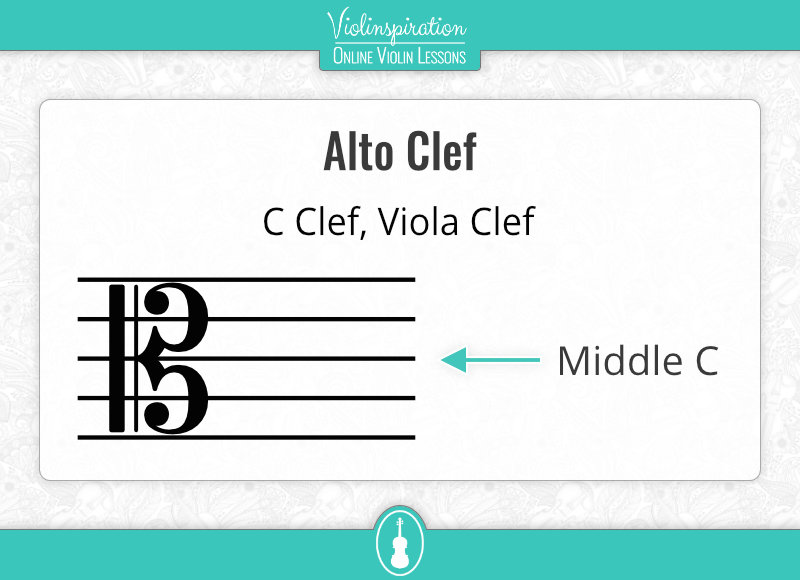
Alto clef, also known as the C clef, looks like the number 3 or a B, and is mostly used by violists. The middle of the clef points to the middle line of the staff, which we call middle C in this context. This is how the alto clef got its nickname: the C clef! Some also refer to the alto clef as the viola clef, or you’ll sometimes even hear it called the countertenor clef.
The C clef can theoretically be moved up or down the staff to move where the middle C is shown, and that’s how we get the tenor clef, our next lower clef.
Tenor Clef (C Clef)
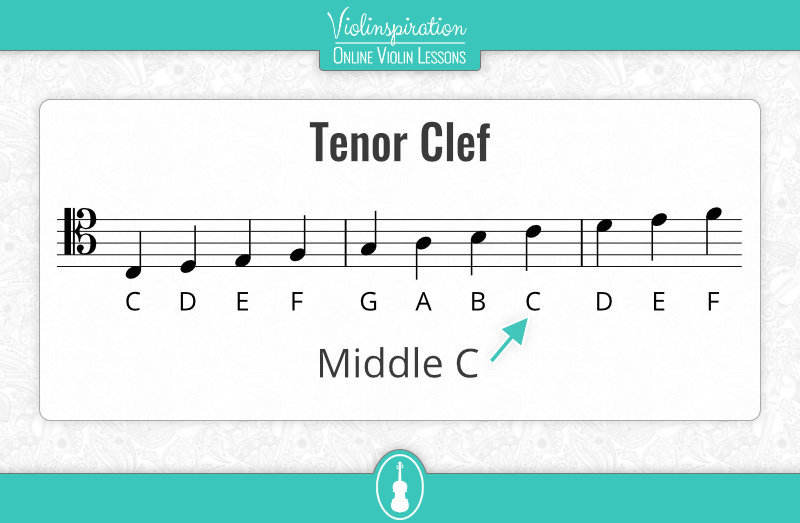
Tenor clef, another C clef, is probably the least used of our modern music clefs. There aren’t any modern instruments that read music only using tenor clef; it’s really only used to show notes in upper ranges of the cello, double bass, bassoon, and trombone.
As I mentioned a moment ago, the tenor clef is a C clef that’s placed differently than the alto clef. This time, the middle of the clef points to the fourth line of the staff. Now this line will be labeled as middle C. This can show a slightly lower range of notes, as the lower lines of the staff are now lower notes than they would be in the alto clef.
Bass Clef (F Clef)
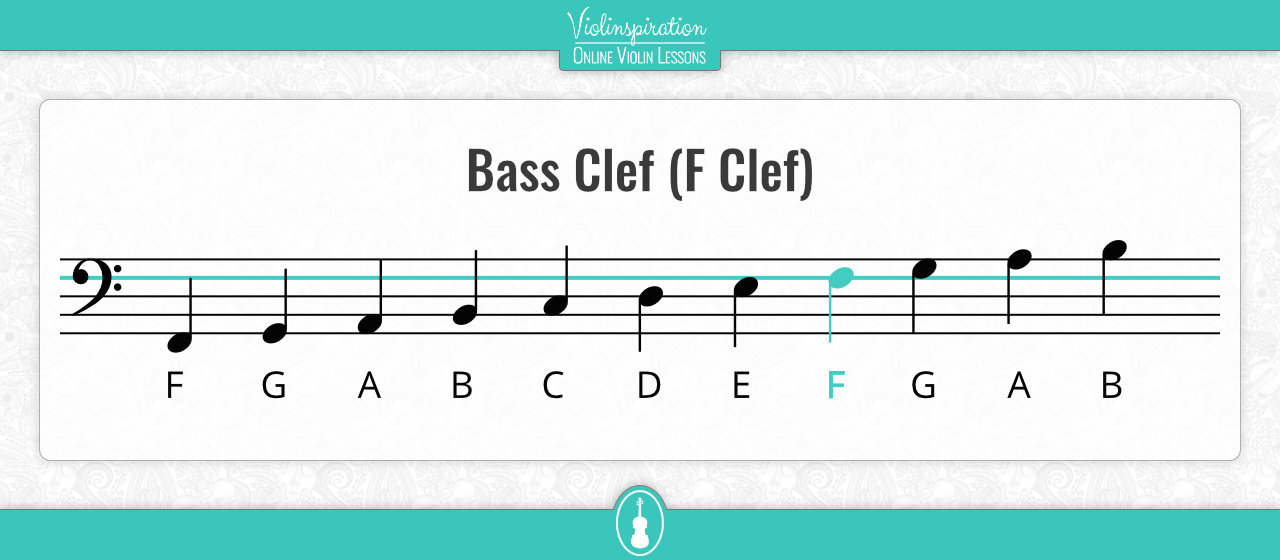
Finally, our clef that shows the lowest notes is the bass clef. This clef is also referred to as the F clef because the two dots surrounding the fourth line tell us that that particular line will be F3, the F a fourth below middle C. This is another helpful reference note to remember: the two dots of the bass clef always surround F; then you can count higher or lower to find any note you might be looking for.

Treble and bass clefs are the two most common clefs in music. The piano, for example, uses them both! Generally, the treble clef is used for the right-hand notes, and the bass clef is the go-to for left-hand notes. Once in a while pianists might see the same clef for each hand: double treble clef symbols indicate that both hands will play upper register notes; whereas double bass clef symbols will show that both hands play low notes.
Clef Relationships
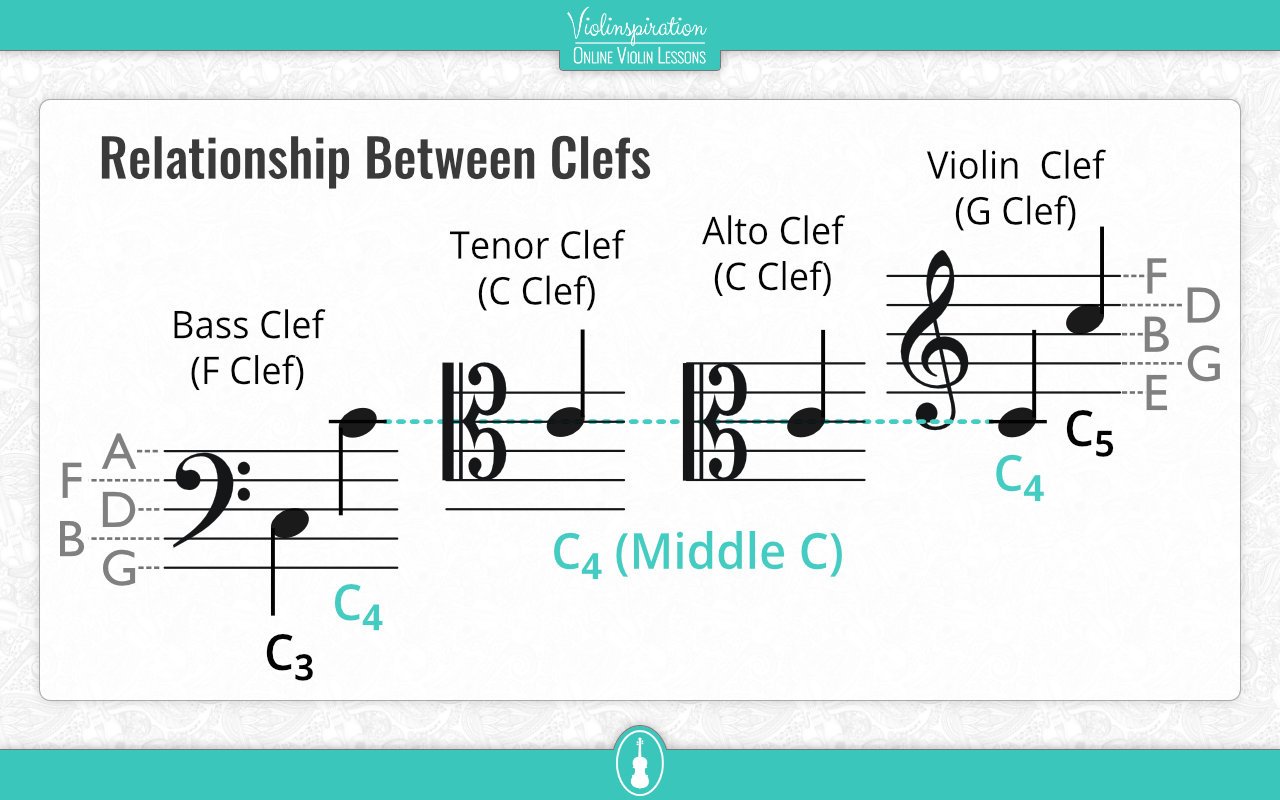
When thinking about different clefs, it’s so helpful to understand how their notes relate and overlap with each other. I love how the graphic above shows where Middle C, along with other octave C’s, sit on the different clefs.
Violin Treble Clef Notes
Reading treble clef notes is one thing, but it’s also important to know where these notes are played on your violin, and what range of notes we usually play. Download my free set of violin fingering charts to help yourself remember the notes and their finger placement on the violin fingerboard!

FREE Violin Fingering Charts
for all the positions
If you’d like to learn or review how to read violin notes, check out How to Read Sheet Music on the Violin.
Old Clef Symbols
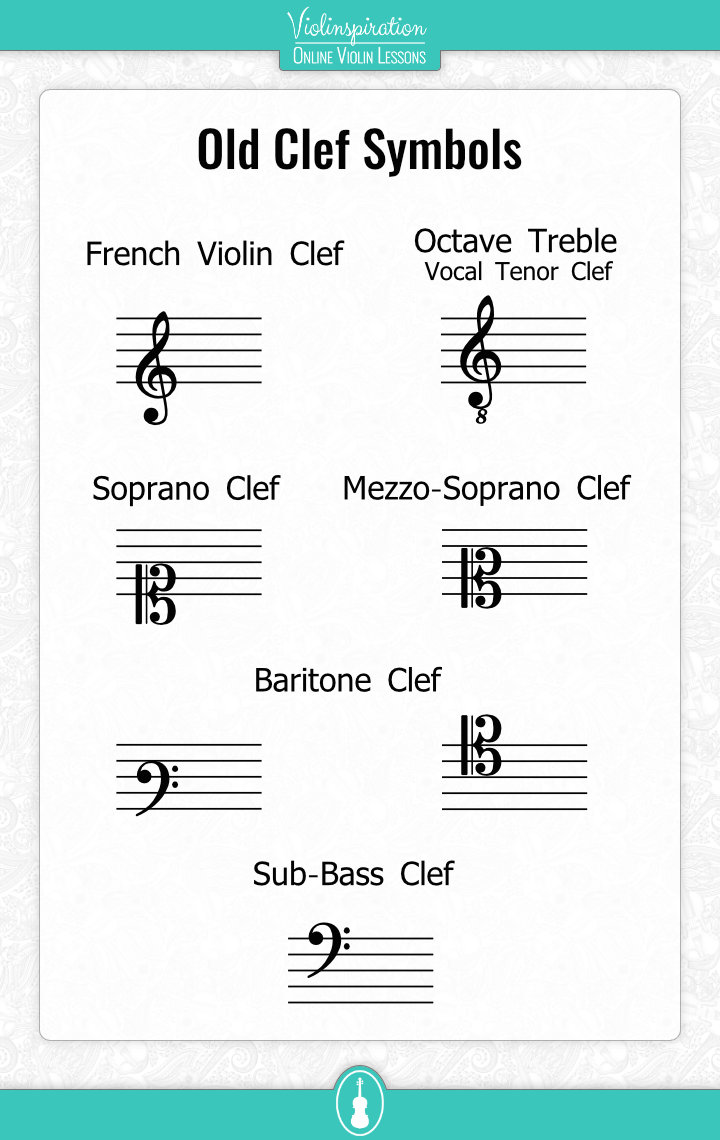
There are a few musical clefs that are no longer regularly used.
Early on in music notation history, composers would use more clefs for specific instruments and voice parts than we do today.
French Violin Clef
The French violin clef is a clef that’s no longer used in modern music, but it was popular in France in the 17th and 18th centuries.
The French violin clef is a G clef that’s centered around the first line of the staff. That makes the lowest line G, which allows us to have higher notes within the upper staff without adding ledger lines.
Soprano Clef
The soprano clef isn’t used today, but you could occasionally find it in historical editions of music. It had been used for the right hand of keyboard music, vocal soprano music, and the upper range of the viola da gamba.
The soprano clef is a C clef that assigns Middle C to the lowest line of the staff.
Mezzo-Soprano Clef
The Mezzo-soprano clef is another clef that has mostly been lost to time. This was a C clef that centered around the second line of the staff. This clef was mostly used for mezzo-soprano vocal parts, so the musicians wouldn’t have to read as many lower ledger lines.
Baritone Clef
The baritone clef was written two different ways: the F clef with the dots centering the middle line of the staff; or the C clef centered around the top line. Both versions were valid and called the baritone clef.
Hundreds of years ago, it was the norm to learn a few different clefs for different instruments and situations, mostly to just avoid reading many ledger lines. Now, we learn 1-4 different clefs and read ledger line notes more often. It’s really just a shift in perspective!
Sub-bass Clef
The sub-bass clef is the F clef placed higher so that the two dots surround the top, fifth line of the staff. This allows room on the staff for much lower notes than the bass clef as we know it today.
The sub-bass clef was used in the Baroque era for bass parts. This clef has the same note placement as the treble clef, but the notes sound two octaves lower.
Octave Treble Clef
A treble clef with an 8 below it tells you to play everything an octave lower than written. This clef is sometimes called the vocal tenor clef because it’s sometimes used for that vocal part to more easily read their music without encountering too many ledger line notes.
Frequently Asked Questions
Does the violin play alto clef?
No, the violin does not play music written in alto clef. Violin music nowadays is always written in treble clef, also known as the G clef. Alto clef is most commonly used in viola sheet music, though upper register notes are commonly written in treble clef.
What clef does the violin play in?
The violin reads music written in the G clef, also called treble clef. The G clef shows the highest notes of all the clefs, and since the violin’s range is the highest of those in the string family, it makes the most sense to use this clef.
Which instruments use which clefs?
Treble Clef

Violin, Piano, Harp, Flute, Oboe, Clarinet, Saxophone, Horn, Trumpet, Cornet, Vibraphone, Xylophone, Mandolin, Recorder, Bagpipes, Guitar, Euphonium
Sometimes:
Viola, Double Bass
Alto Clef
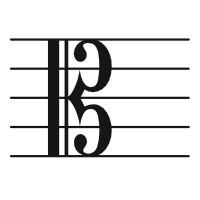
Viola, Viola d‘amore, Viola da gamba, Alto trombone, Mandola
Tenor Clef
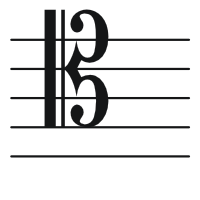
Sometimes:
Viola da gamba, Cello, Double Bass, Bassoon, Euphonium, Tenor trombone
Bass Clef
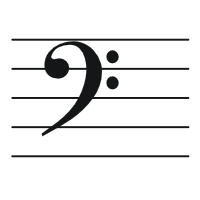
Piano, Cello, Double Bass, Bass guitar, Bassoon, Contrabassoon, Bass recorder, Trombone, Tuba, Timpani, Euphonium
The table above shows all instruments and the clefs they read from.
As for string instruments, the violin always reads treble clef, and the viola uses alto clef and sometimes treble clef for high notes. Cellists and double bassists most often read bass clef, but for higher notes, they’ll sometimes need to read tenor clef and treble clef!
Learn more…
All violin music is written using treble clef, or G clef, which makes learning how to read violin sheet music a little simpler than other instruments. Some musicians have to learn how to read multiple clefs just to read one instrument!
I hope this article helped you understand the violin clef. If you’d like to deepen your music theory knowledge, I suggest reading Time Signatures in Music or The Range of the Violin next.
